There are three trends that prevail across the globe-convenience, indulgence and wellness. Fortunately for the dairy industry, all offerings can be formulated or packaged in such a way as to meet one or more of these trends.
Yogurt, by far, is the most active category in terms of new products overseas. Europe leads with the number of new yogurt products (1,234) introduced in 2003. There is a chance that this number will be exceeded in 2004, as the year has been a very active one for yogurt innovations.
Formats and product types include drinkable yogurt, smoothies, fromage frais and quark, in addition to standard cup yogurt. Category lines continue to blur as smoothies and drinkable yogurts are positioned as meal replacements and are easily adaptable to the demands of on-the-go lifestyles.
In general, better-for-you products are very prevalent in the yogurt category. However, on the flip side, we continue to see certain yogurt products positioned as desserts. These usually are formulated with indulgent flavors. In addition, multiple flavor combinations are becoming quite popular overseas.
Yogurts targeting kids continue to be popular snack choices for parents as the flavors offered satisfy children and nutritional content appeals to parents. Also, overseas companies have been more aggressive with encouraging consumers to enjoy yogurt products throughout the day, such as for a snack or light meal.
There is potential to increase efforts with targeting women through positioning statements that address women's health needs. Multiple flavor combinations, especially incorporating tropical fruits, will also likely become much more common.
Cheese-a mature, yet flavorfully innovative category
Cheese is a mature market that has witnessed some innovation in the past few years; however, most true innovations (e.g., cholesterol-reducing cheese) are still fairly small segments of global cheese launches. Most new cheese products focus on flavor and indulgence, as the failure of non-fat cheeses in the early 1990s is still fresh on most consumers' minds.As with yogurt, Europe led the world in the number of cheese products introduced in 2003 with 979 launches. The continent is most likely going to exceed that figure in 2004.
About 20% of all new cheese products promote some sort of flavor, with garlic being the most prevalent. Other popular flavors added to all types of cheese include basil, Italian, paprika, pepper, smoke and tomato.
Cheese trends expected to increase globally include the popularity of all types of ethnic cheeses, and these cheeses will become more popular all around the world. Authenticity, in terms of how the cheese is manufactured, where it is made or other attributes, will also continue to grow, particularly throughout the European Union.
Although some cheeses already are targeted to children, and upscale or unusually flavored cheeses may appear to be targeted to adults, opportunity still exists for additional varieties. Look for fruit flavor combinations, as we currently see in yogurt products, show up in cheese.
Milk and butter-very established markets
The market for milk is an established one, but this category remains alive overseas due to a strong focus on health issues. Better-for-you products concentrate on fortification, less fat and added calcium claims. Furthermore, category lines continue to blur as milk products become more substantial in terms of providing energy, nutrients and other attributes.A small percentage of new milk products target a specific age or gender demographic; however, about three quarters of those targeted demographics are focused on children between five and 12 years old. Some real innovators are formulating milk products to target kids, teens and women.
Positioning milk products to the various target segments often includes focusing on the specific benefits that suit that particular segment. Kids' products target children directly through fun messages via the design (cartoon characters on the label, convenient package with a straw included, etc.) or the flavor. Companies target children indirectly through their parents because of the nutritional value of milk. Very few products exist overseas that are targeted to teens. This presents an opportunity for innovators.
Because of the fear of osteoporosis, women are an important target group for many dairies. Women are usually grouped into three different segments, each with ingredients applicable to their life stage. For pre-natal, pregnancy and post-pregnancy females, milks often contain additional folic acid and calcium. For menopausal women, soy is an ingredient that helps curb mood swings and hot flashes. And, in general, for all adult women, milk contains extra calcium.
Understanding why, when and how consumers use milk products is necessary in order for manufacturers to continue movement in this mature category. This will be especially important with products that blur the category lines. We will see more overseas milk products resemble meal replacements, with companies encouraging consumers to enjoy the milk products throughout the day, not just in the morning.
Also, authenticity, or positioning the milk product based on the geographic source, may become more common in order to differentiate from the competition. There are currently products that focus on the type of cow the milk comes from (e.g. Jersey cow vs. Holstein cow), or the time of day that the cow is milked.
Companies will continue their efforts to target kids, teens and women through positioning statements that address each segment's needs. Products will most likely need to have added benefits that speak to each of these groups' needs. We will see more products aimed at mature adults, not just menopausal women.
And lastly for milk, we will see multiple flavor combinations, especially incorporating tropical fruits.
Butter is also a mature category, where innovation is less common than in other categories. Innovations typically focus on flavors and forms. In fact, any product that offers a differentiating point is a welcome sight because it has the potential to awaken the category. In the United Kingdom, Highgrove Foods introduced Highgrove Truffle Butter. This product is said to be an "ideal partner for scrambled eggs and omelets; or tossed into cooked pasta or rice; or simply melted into baked or mashed potatoes for a unique taste of heaven." In Italy, Iper introduced Burro butter, which is made at mountain dairies with milk from cows who have been fed with only fresh grass, hay and vegetable products.
We continue to see other dairy foods such as sour cream and yogurt blended into butter for a unique flavor profile, and even added value in terms of delivering live and active cultures to the consumer.
We also continue to see a small variety of flavors, led by garlic, being added to butter. Other flavors showing up in butter include blue cheese, tomato and basil, chili and sea salt. Opportunity definitely exists for more flavored butters, geared to specific usage occasions. For example, chive or cheese-flavored butter goes with eggs. Fruit-flavored butter goes well with muffins. And, maple-flavored butter would make an excellent topping for pancakes or French toast.
Sweet treats-Decadence in the freezer and the fridge
The popularity of "on-the-go" snacking continues to drive overseas frozen dessert marketers to manufacture bite-sized, mini portions that consumers can easily eat between meals. In terms of frozen novelties, many overseas manufacturers are focusing on making products that are refreshing. Thus, many manufacturers are incorporating natural fruit juices into novelties, and others are capitalizing on the increasing popularity of smoothies.Different or unusual shapes and formats are helping global marketers add interest to frozen novelties. For example, in Japan, Morinaga now offers Choice Biscuit Choco Ice, which is a half chocolate-coated ice cream bar topped with two butter biscuits.
In packaged ice cream, variety is the word. One can find in almost any freezer ice creams that are rich and packed with exotic ingredients. Next to them are products for health-conscious consumers that take the form of being low calorie, low fat and/or low sugar. Lowering carbohydrates has not been very popular overseas, but that is expected to change in the next few years. For a twist, some global ice cream manufacturers offer spicy products, as well as frozen desserts with alcohol.
The potential exists for functional and fortified ice creams, for example, ice cream with added calcium or added probiotic bacteria.
Refrigerated dairy desserts, by far, are a category that U.S. dairy processors can learn a lot from their peers overseas. There are many innovations in this category ranging from overly indulgent, full-fat options, true to the traditional meaning of "dessert," as well as low-fat, low-calorie and low-sugar options, which are targeted to dieters and health-conscious consumers who want full flavor with less calories. Packaging innovations focus on convenience and portability, with containers often including a spoon or fork.
Endorsements from well-known chefs, the inclusion of alcohol and full-fat, full-flavor recipes has led to a strong indulgent dairy dessert segment. Fun flavors such as cotton candy are being used in desserts targeted to children. Ethnic flavors work well in adult desserts, where a host can bring a touch of the exotic to the dinner table.
On the healthful side of refrigerated dairy desserts, there have been some innovations in functional products, which include better-for-you ingredients. Also, fruit desserts typically contain a large percentage of fruit to appeal to health-conscious consumers.
Hope you enjoy this snapshot of dairy innovations from around the world.
Weight Watchers Low Fat Cheese Spread is a soft cheese fortified with vitamins A, C and E. It contains 56 calories per serving and is packaged in 150g plastic recloseable, rectangular containers.

Through a little formulation refining and changes in marketing direction, B-Fast Breakfast on the Go was replaced recently by Yoplait Le Rice, a blend of rice and milk with premium fruits or sauces. It can be eaten cold from the fridge, or warmed in the microwave for a winter warmer-upper. Yoplait Le Rice is 97% fat free. The line comes in seven varieties: Apple Cinnamon, Banana & Honey, Classic Vanilla, Mountain Berries, Smooth Caramel, Strawberries & Cream and Tropical Mango.
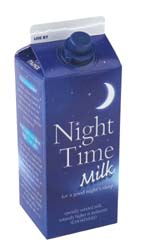
Night Time Milk is simply cows milk from the first milking of the morning, when melatonin levels are highest. As with humans, not all cows produce the same amount of melatonin, which is why Night Time Milk is provided by herds that have been specially selected for their ability to produce milk that is naturally higher in melatonin. Night Time Milk tastes just like regular cows milk and is just as nutritious. All that is different is the higher levels of melatonin. Night Time Milk has a 1.7% fat content.
Night Time Milk, which is designed to be consumed warm as part of the bedtime routine, can also be enjoyed during the day without causing drowsiness. This is due to the fact that human levels of melatonin are naturally very low during daylight hours.
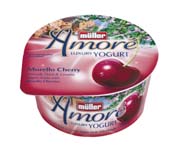
"With premium brands becoming increasingly attractive to consumers, we are ensuring our range is constantly updated to guarantee its continued appeal," says Andrew Harrison, gen. mgr., at U.K.-based Müller Dairy Ltd. "The addition of Morello Cherry to the range offers something different, while complementing the continental taste consumers expect from the Amoré brand."
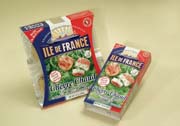
The new package technology, which features a parchment-wrapped Camembert packed in a freshness sealed box, preserves the cheese flavor much longer without losing any of its original qualities. The process enables the cheese to age to perfection and stop its evolution until the seal is broken when opened.
Also, exclusive to Ile de France and available for the first time is Chèvre Chaud-mini fresh goat cheese delicately coated in toasted bread crumbs. A renowned dish from gourmet French restaurant chefs, Chèvre Chaud requires only a few minutes of heating in a pan and, once heated, features a warm, crispy exterior, complemented by the natural freshness of the goat cheese.
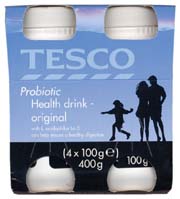
In Spain, Nestlé has launched Sveltesse Fruta y Leche 0%, a skimmed fermented milk drink with peach juice containing 0% fat. Sold in 720ml hour-glass shaped recloseable, plastic bottles, Sveltesse is targeted to calorie-conscious females.
Japan's Koiwai Dairy Products recently rolled out a homemade-style yogurt that is all about health and wellness. The yogurt contains big chunks of grapefruit, which are high in the antioxidant vitamin C, and aloe vera pulp, which is considered a natural healing food that slows down the aging process.
Earlier this year, also in Japan, Meiji Dairies Corp., debuted its idea of a beautifying yogurt. VI-You yogurt contains collagen and ceramide, two ingredients recognized for their anti-aging, anti-wrinkling attributes. VI-You also comes in the very popular refreshing grapefruit flavor.
Pouch packaging is changing the face of yogurt. U.K.-based St. Ivel offers its popular better-for-you Shape yogurt line in a container that enables spoonless eating. Unlike the tubes used in the United States for spoonless consumption, Shape 2 Go's container is recloseable, making it more convenient for on-the-go eating.
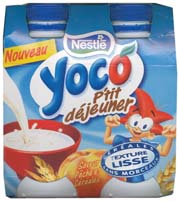

Probiotic cultures are not limited to dairy foods such as yogurt and smoothies. Migros dairy in Switzerland has launched a spread based on butter and whole milk probiotic-containing yogurt.
Arla Foods, which has distribution in Denmark, Sweden (its home country) and throughout the United Kingdom, has joined the Smoothie market. The single-serve bottle line includes flavors such as passion fruit, raspberry and strawberry.
Original ProViva from Sweden's Skane Dairy is a dairy-free fruit juice containing the probiotic bacteria Lactobacillus plantarum 299v. The first ProViva products came in 1-liter cartons and contained multiple servings. Recently, the company introduced ProViva Shot, which comes in 80ml daily dose "pots." The Shot is a concentrated form of ProViva and contains fives times as many bacteria as the equivalent quantity of the original ProViva fruit drink. These Proviva lines are distributed in select countries throughout Europe.
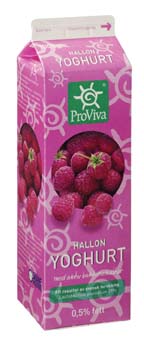
Masterfoods, a division of Mars Inc., McLean, Va., now markets a chocolate dairy shot drink called Cocoa Via in select European countries. Previously called Positively Healthy Cocoa Drink, the beverage is a delicious, low-fat chocolaty drink made with healthy CocoaPro-branded cocoa. It contains skimmed milk and just 69 calories and 0.6g fat per 85ml bottle, together with high amounts (more than 100mg) of natural cocoa antioxidants (flavonoids).
CocoaVia drink is high in the natural cocoa goodness that helps keep hearts healthy. The natural goodness of cocoa comes from a group of compounds that health experts call flavonoids, which help keep the heart and circulation going well.
CocoaPro is a proprietary method of handling cocoa beans so that more of the natural levels of antioxidants are retained. The CocoaPro logo signifies the company's promise that the product has undergone a process that helps to retain more of the cocoa flavonoids.
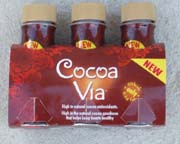
Probiotic yogurt drinks are alive and doing very well in single-serve, on-the-go bottles. The U.K.'s mega department store chain Marks & Spencer markets a range of private label probiotic yogurt drinks, including product in the "count on us" line, which is a range of more than 200 foods that contain less than 3% fat, are low in calories and low in salt.
Innocent Ltd., calls its probiotic drinkable yogurts "thickies." The company offers two varieties: Vanilla Bean & Honey and Mangoes & Coconuts.
Marks & Spencer markets Chantilly Cream, which is about 93% dairy cream, and is sweetened with sugar and flavored slightly with vanilla. It is designed to be poured over desserts and ice cream. There's nothing like it in the United States!
Café Met is the United Kingdom's fastest growing milk drink. From Sweden's Arla Foods, Café Met is sold in single-serve glass bottles for premium positioning. Recently, a special edition Hazelatte flavor joined Mochalatte and Chocolatte. The latter is truly a superpremium chocolate milk. Stabilizer-free, consumers can see the premium chocolate settled to the bottom of the glass bottle. Shaking is rec-ommended before consumption.
For those requiring an energy-boosting snack to get them from meal to meal, brand-new Müllerice Banana with added Glucose is an instant energy hit. Other Müllerice chilled dairy desserts are based on fruit, milk and rice, similar to the new variety; however, the new banana version contains added glucose for an added energy boost. It is targeted to active, on-the-go people and is described as "filling not fattening," whatever time of day.
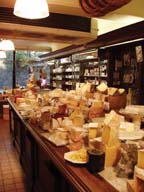
Sidebar: European's Take Their Cheese Quite Seriously
There's no doubt that U.S. consumers' taste buds are changing, and in fact, in recent years have become quite more refined in the way of cheese. It helps that the United States is also now home to quite a few very recent World Cheese Awards winners (see story on page 28). However, nothing compares to the cheese shops in Europe, stores dedicated to those who appreciate only the best cheeses that man can make.Cheesemaking, much like winemaking, something we have learned to excel in in the United States, is the art of doing as little as possible to interfere with nature. According to Paxton & Whitfield, London, purveyors of cheese for more than 200 years, the finesse and delicacy of cheese that is so enticing is lost with too much interference. Therefore, the best cheeses are made in small quantities by artisan producers, usually using the milk of one farm. Cheesemongers such as Paxton & Whitfield pride themselves on sourcing and maturing only the most exceptional cheeses from around the world.
Also in London, La Fromagerie was founded in 1991 by Patricia Michelson, who turned her garden shed into a cheese cave and introduced properly matured farmhouse cheeses sourced direct from small independent cheesemakers to an eager public. The business has emerged as a major player in the cheese world, with its stylish unconventional shop a window for the best kept cheeses and other specialty foods from Europe.
In the United States, specialty or artisan cheeses are defined (though not legally) as value-added products that command a premium price. According to the Wisconsin Specialty Cheese Institute, the nature of specialty cheese is derived from one or more unique qualities, such as exotic origin, particular processing, design, limited supply, unusual application or use, and extraordinary packaging or channel of sale. All specialty cheeses definitely have one thing in common-they are of the highest quality.
